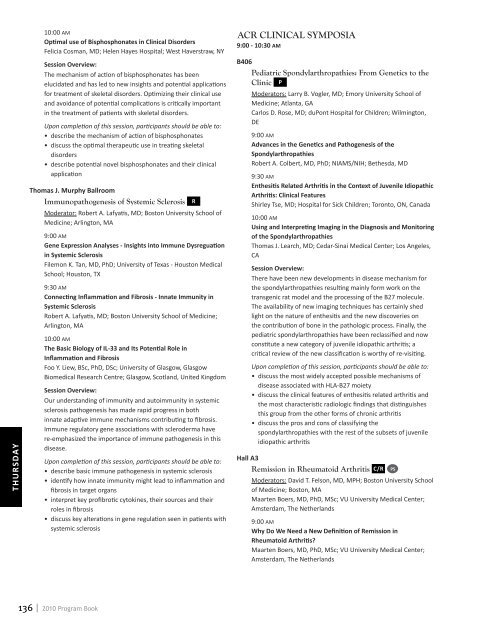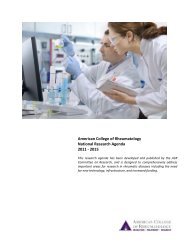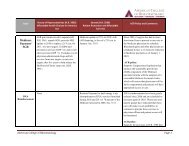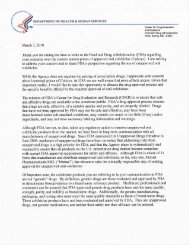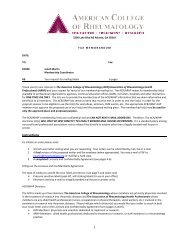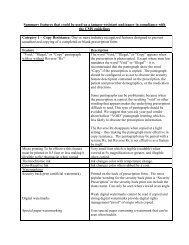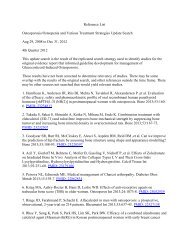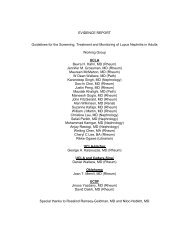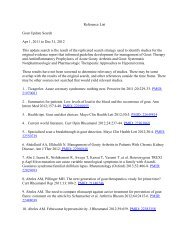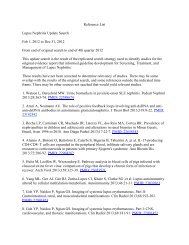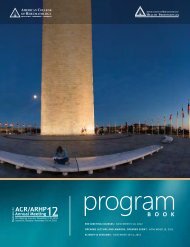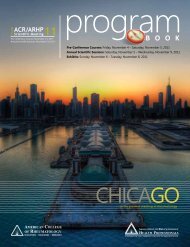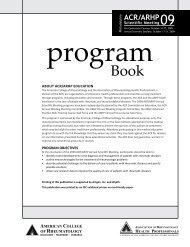B O O K - American College of Rheumatology
B O O K - American College of Rheumatology
B O O K - American College of Rheumatology
Create successful ePaper yourself
Turn your PDF publications into a flip-book with our unique Google optimized e-Paper software.
thursday<br />
10:00 AM<br />
Optimal use <strong>of</strong> Bisphosphonates in Clinical Disorders<br />
Felicia Cosman, MD; Helen Hayes Hospital; West Haverstraw, NY<br />
Session Overview:<br />
The mechanism <strong>of</strong> action <strong>of</strong> bisphosphonates has been<br />
elucidated and has led to new insights and potential applications<br />
for treatment <strong>of</strong> skeletal disorders. Optimizing their clinical use<br />
and avoidance <strong>of</strong> potential complications is critically important<br />
in the treatment <strong>of</strong> patients with skeletal disorders.<br />
Upon completion <strong>of</strong> this session, participants should be able to:<br />
• describe the mechanism <strong>of</strong> action <strong>of</strong> bisphosphonates<br />
• discuss the optimal therapeutic use in treating skeletal<br />
disorders<br />
• describe potential novel bisphosphonates and their clinical<br />
application<br />
Thomas J. Murphy Ballroom<br />
Immunopathogenesis <strong>of</strong> Systemic Sclerosis R<br />
Moderator: Robert A. Lafyatis, MD; Boston University School <strong>of</strong><br />
Medicine; Arlington, MA<br />
9:00 AM<br />
Gene Expression Analyses - Insights into Immune Dysreguation<br />
in Systemic Sclerosis<br />
Filemon K. Tan, MD, PhD; University <strong>of</strong> Texas - Houston Medical<br />
School; Houston, TX<br />
9:30 AM<br />
Connecting Inflammation and Fibrosis - Innate Immunity in<br />
Systemic Sclerosis<br />
Robert A. Lafyatis, MD; Boston University School <strong>of</strong> Medicine;<br />
Arlington, MA<br />
10:00 AM<br />
The Basic Biology <strong>of</strong> IL-33 and Its Potential Role in<br />
Inflammation and Fibrosis<br />
Foo Y. Liew, BSc, PhD, DSc; University <strong>of</strong> Glasgow, Glasgow<br />
Biomedical Research Centre; Glasgow, Scotland, United Kingdom<br />
Session Overview:<br />
Our understanding <strong>of</strong> immunity and autoimmunity in systemic<br />
sclerosis pathogenesis has made rapid progress in both<br />
innate adaptive immune mechanisms contributing to fibrosis.<br />
Immune regulatory gene associations with scleroderma have<br />
re-emphasized the importance <strong>of</strong> immune pathogenesis in this<br />
disease.<br />
Upon completion <strong>of</strong> this session, participants should be able to:<br />
• describe basic immune pathogenesis in systemic sclerosis<br />
• identify how innate immunity might lead to inflammation and<br />
fibrosis in target organs<br />
• interpret key pr<strong>of</strong>ibrotic cytokines, their sources and their<br />
roles in fibrosis<br />
• discuss key alterations in gene regulation seen in patients with<br />
systemic sclerosis<br />
ACR Clinical Symposia<br />
9:00 - 10:30 AM<br />
B406<br />
Pediatric Spondylarthropathies: From Genetics to the<br />
Clinic P<br />
Moderators: Larry B. Vogler, MD; Emory University School <strong>of</strong><br />
Medicine; Atlanta, GA<br />
Carlos D. Rose, MD; duPont Hospital for Children; Wilmington,<br />
DE<br />
9:00 AM<br />
Advances in the Genetics and Pathogenesis <strong>of</strong> the<br />
Spondylarthropathies<br />
Robert A. Colbert, MD, PhD; NIAMS/NIH; Bethesda, MD<br />
9:30 AM<br />
Enthesitis Related Arthritis in the Context <strong>of</strong> Juvenile Idiopathic<br />
Arthritis: Clinical Features<br />
Shirley Tse, MD; Hospital for Sick Children; Toronto, ON, Canada<br />
10:00 AM<br />
Using and Interpreting Imaging in the Diagnosis and Monitoring<br />
<strong>of</strong> the Spondylarthropathies<br />
Thomas J. Learch, MD; Cedar-Sinai Medical Center; Los Angeles,<br />
CA<br />
Session Overview:<br />
There have been new developments in disease mechanism for<br />
the spondylarthropathies resulting mainly form work on the<br />
transgenic rat model and the processing <strong>of</strong> the B27 molecule.<br />
The availability <strong>of</strong> new imaging techniques has certainly shed<br />
light on the nature <strong>of</strong> enthesitis and the new discoveries on<br />
the contribution <strong>of</strong> bone in the pathologic process. Finally, the<br />
pediatric spondylarthropathies have been reclassified and now<br />
constitute a new category <strong>of</strong> juvenile idiopathic arthritis; a<br />
critical review <strong>of</strong> the new classification is worthy <strong>of</strong> re-visiting.<br />
Upon completion <strong>of</strong> this session, participants should be able to:<br />
• discuss the most widely accepted possible mechanisms <strong>of</strong><br />
disease associated with HLA-B27 moiety<br />
• discuss the clinical features <strong>of</strong> enthesitis related arthritis and<br />
the most characteristic radiologic findings that distinguishes<br />
this group from the other forms <strong>of</strong> chronic arthritis<br />
• discuss the pros and cons <strong>of</strong> classifying the<br />
spondylarthropathies with the rest <strong>of</strong> the subsets <strong>of</strong> juvenile<br />
idiopathic arthritis<br />
Hall A3<br />
Remission in Rheumatoid Arthritis c/r PS<br />
Moderators: David T. Felson, MD, MPH; Boston University School<br />
<strong>of</strong> Medicine; Boston, MA<br />
Maarten Boers, MD, PhD, MSc; VU University Medical Center;<br />
Amsterdam, The Netherlands<br />
9:00 AM<br />
Why Do We Need a New Definition <strong>of</strong> Remission in<br />
Rheumatoid Arthritis?<br />
Maarten Boers, MD, PhD, MSc; VU University Medical Center;<br />
Amsterdam, The Netherlands<br />
136<br />
2010 Program Book


